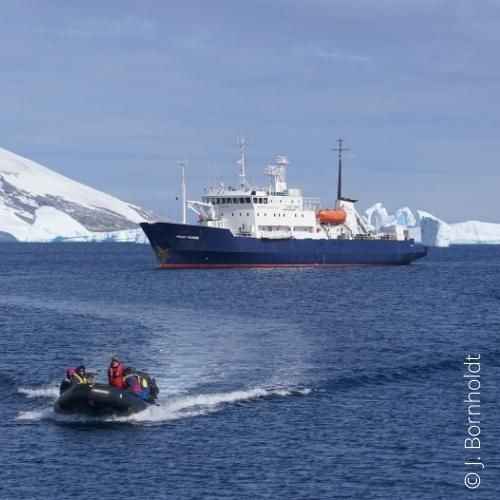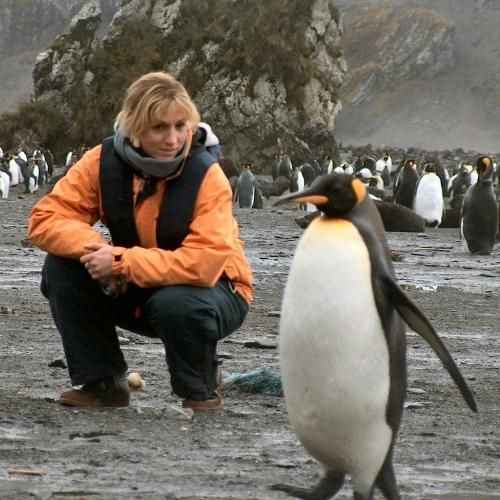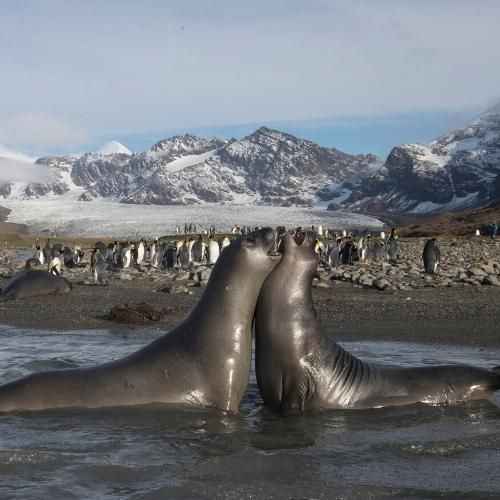Polar Pioneer
Polar Pioneer was built in Finland in 1985 as an ice-strengthened research ship, and for many years she plied the treacherous waters of the USSR's northern coast. In 2000 she was refurbished in St Petersburg to provide comfortable accommodation for 56 passengers. A combined bar/lounge/library area (stocked with a good collection of polar books) was also created by simple internal restructuring.
This class of vessel has a fine reputation for polar expedition cruising, due to its strength, manoeuvrability and small number of cabins. All cabins have outside portholes plus ample storage space. You will find a range of accommodation types, including triple and twin cabins as well as larger suites, all featuring outside facing portholes or windows and ample storage space for your gear. Cabins have either shared or private bathroom facilities, whilst suites offer en suite bathrooms and lounge areas.The Russian captain and crew are among the most experienced ice-navigators in the world and their enthusiasm is legendary.
The Polar Pioneer is not a luxury vessel. The accommodations are simple yet comfortable, and the meals are wholesome and uncomplicated. The ship has a combined bar/lounge/library area, the bridge is always open to us, and the decks are ideal for viewing. The chefs are Australian, and the dining room is attended by Russian stewardesses. Dining is Family Style - platters set on tables which everyone shares from. A small fleet of inflatable Zodiacs with outboard motors help you get from from ship to shore.
Embarkation and At Sea
Sailing towards South Georgia, we settle into shipboard life and enjoy our first meal on board. Before our first landing we will be given guidelines for approaching the wildlife and talk about the implications of the Antarctic Treaty, as well as being briefed about using our zodiacs for excursions from the ship.
A favorite pastime is to stand at the stern deck watching the many seabirds, including majestic albatrosses and giant petrels, following in our wake, skillfully using the air currents created by the ship to gain momentum. You may decide to join the whale watchers on the bridge, or just relax and read a favorite book. Our sea journey will take approximately 2,5 days before we reach South Georgia
If time and weather conditions permit, we could pass close to Shag Rocks, a fascinating group of jagged rocky islets protruding from the sea. Blue-eyed cormorants fill the air; their precarious nesting sites are white with guano.
South Georgia is a tiny speck in the South Atlantic Ocean, located in one of the most desolate parts of our planet. A 3,000-metre mountain range traces the spine of this long, narrow island. Though geographically speaking, the island lies in the Subantarctic area, it has a climate more in keeping with the true Antarctic regions. This is because South Georgia lies wholly within the Antarctic Convergence.
On 20 May 1916, Sir Ernest Shackleton, Crean and Worsley stumbled into the busy whaling station at Stromness; hungry, exhausted and covered in grime. They had just made the first ever crossing of the mountains of South Georgia, to find help for their three exhausted companions left at Cave Cove and rescue the men they had left on Elephant Island. They had sailed for 16 days under horrendous conditions and found safety in the tiny entrance of Cave Cove. This epic story of survival had begun with the sinking of his ship, the Endurance, in the Weddell Sea, six months earlier.
As you explore South Georgia, you will have the opportunity to reflect on Shackleton’s epic journey.
You may visit the following exciting places if conditions and time allows: Grytviken
Originally a Norwegian sealing and whaling station, it was finally abandoned in 1965. Here we must be careful to avoid stepping on sleeping elephant seals as we skirt the ruins of factory buildings peering into the past, trying to imagine what it was like when whale processing was in full swing. Abandoned ships lie sunken alongside old wharves, while pitted concrete walls remind us of the more recent Falkland's war, which started here.
Sir Ernest Shackleton died from a heart attack during his final expedition on board the Quest on the 6th of May 1922. His body was laid to rest at Grytviken and we hope to make a pilgrimage to visit the cross his men erected in his memory looking out across beautiful Cumberland Bay.
St. Andrews Bay
The sandy black beach is a resting place for hundreds of Elephant seals that haul out on the shore to moult. Behind the beach, the sight and sound of tens upon tens of thousands of King penguins at different stages of their breeding cycle will be overwhelming. The glacial river that runs into the sea here will be alive with penguin chicks and Elephant seal pups testing their aquatic skills. If we lift our gaze from the wildlife for a moment, we will glimpse the snow-capped peaks of some of the world's most spectacular mountains.
Godthul
Imagine indented bays lined with bleached whalebones, teeming with fur seals and with penguins just 'hanging about'. Here you have the opportunity to clamber through the tussock to a spectacular plateau offering magnificent views across the island and the waters beyond. A careful descent leads us to a magnificent Macaroni penguin rookery.
Prion Island
We will aim to visit Prion Island where we can sit quietly to watch serene wandering albatrosses sitting proudly on eggs or cute downy chicks. We may be blessed by the performance of an intimate courtship dance, or may witness a youngster being lovingly fed. We watch adolescents exercising their wide wing spans, trying to launch themselves into the air, as they realise that Mum and Dad will no longer feed them and they must leave the island in search of food.
Other stunning wildlife destinations we may visit include:
Elsehul Bay - Royal Harbour - Cooper Bay - Drygalski Fjord - Larsen Harbour - Stromness - Salisbury Plains - Gold Harbour - Right Whale Bay - Possession Bay.
Leaving South Georgia we head across the Scotia Sea in a south-westerly direction. The ocean takes on a whole new perspective once we are surrounded by the surreal presence of floating ice sculptures. The memory of the sight of your first iceberg will remain with you forever. We look out for great whales and possibly our first icebergs!
South Orkney Islands
If pack ice allows, we go ashore in the dramatic South Orkney Islands, then across whale-rich waters to Elephant Island, hoping to take zodiacs near Point Wild, where Shackleton's men wintered over. After their ship the Endurance was crushed in pack ice in the Weddell Sea, Shackleton and his men climbed into three open boats and finally, on 14 April 1916, made landfall on this tiny toe of rock and ice in the vastness of the Southern Ocean. The men had not been on land for sixteen months! We will attempt to make at least one landing on historic Elephant Island.
Antarctic Peninsula
Once we arrive in the calmer waters of the Bransfield and Gerlache Straits, we will generally make landings, activities and zodiac excursions two to three times a day. Sometimes we will cruise along spectacular ice cliffs, or follow whales that are feeding near the surface.
Half Moon Island
A wildlife rich island tucked into a neat bay at the eastern end of Livingston Island. On a clear day the glaciers and mountains of Livingston Island dominate the scene. There is a large Chinstrap penguin rookery tucked in between basaltic turrets coloured by yellow and orange lichens. Gulls nest on these turrets and there are often Fur seals and Elephant seals hauled out on the pebble beaches. At one extremity of the island there is a large colony of nesting Blue-Eyed shags. At the other end lies a small Argentine station that is sometimes occupied by scientists conducting research on the penguin colony and surrounding waterways.
Paradise Harbour
A protected bay surrounded by magnificent peaks and spectacular glaciers, the rocky cliffs of this unforgettable piece of heaven provide perfect nesting sites for Blue-Eyed shags, terns and gulls. The serenity of Paradise Harbour envelops us once the sound of the dropping anchor fades from our ears. This is a haven for whales and we keep our eyes open for Humpbacks, Orcas and Minkes, as well as Crabeater seals, as we explore the bay in zodiacs. Imagine being so close to a whale that when he surfaces to blow, the fishy spray of his exhalation momentarily blurs your vision. Words cannot describe this experience.
At Sea - Drake Passage
Time to head back to Tierra del Fuego, with lectures and videos to complete our Antarctic education. This is a time for reflection and discussion about what you have seen and felt, and the impact this voyage has had on our attitude to life. As we approach the tip of South America, our Captain may sail close to legendary Cape Horn, weather conditions permitting.
Ushuaia and Disembarkation
During the early morning we cruise up the Beagle Channel, before quietly slipping into dock in Ushuaia about 07:00 am. As soon as customs have cleared the ship we will be free to disembark. It's a busy time, with people saying farewell to the crew and to fellow passengers who have shared the intensity of exploring this magnificent white wilderness. You head off in different directions, hopefully with a newfound sense of the immense power of nature.
Dining
Our professional chefs present three healthy, delicious meals daily, with morning and afternoon tea available in the dining rooms in between. All of our produce is sourced locally, with fresh fruit and vegetables, and freshly baked bread and pastries, served wherever possible. We are able to cater for a range of special meal requests, including vegetarian, vegan, gluten free, lactose free and other allergy specific requirements – please ensure you list this on your personal details form.
Observation Decks
Our spacious observation decks provide a congenial place to watch for wildlife or follow the ship’s progress on nautical charts. Rug up for unparalleled scenery from the outer decks or flying bridge, where our naturalists help you identify wildlife.
Learning and Lectures
At sea, join our polar specialists as they entertain and inform us with illustrated talks, and prepare us for making shore visits with mandatory safety and environmental briefings.
Captain and Crew
Our highly experienced Russian captain and crew are among the best ice navigators in the world. Our efficient stewardesses attend to rooms and serve our meals, whilst the crew work mainly behind-the-scenes to help our expedition leader get the ship to where we want to go.
Getting Ashore
Polar Pioneer boasts a fleet of Zodiacs that transport us ashore to penguin rookeries, scientific stations and historic sites, and provide us with a platform for photography. Our small excursion crafts take us beyond the reach of giant cruisers, and our philosophy of “getting out amongst it” is put to practice.
Medical Clinic
A basic medical clinic is managed by our English-speaking Ship’s Doctor, who is available at all times to assist with bouts of sea sickness and other unexpected emergencies.
On-board Entertainment
From socialising in our fully-stocked lounge bar to enjoying Captain’s drinks, trivia nights and charity auctions, or escaping to the sauna for some R&R; our small ship offers some fun entertainment options for when we’re not out and about.
Technology and Connectivity
Polar Pioneer has communication services that are available for an additional fee. These include satellite telephone, email and fax. Please note that these services are basic and not suitable for continuous use. Internet access is available on board for an additional cost. Please note that due to the remote nature of our expeditions, connection cannot always be guaranteed.
